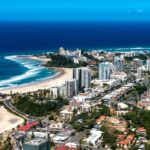
The History of Coolangatta
History
For more than a century, Coolangatta has been a favourite escape from the more hectic cities of Queensland and New South Wales.
This quiet suburb between the states has a long and colourful history, from the voyage of the Endeavour to the establishing of an international airport connecting Coolangatta to the world.
Founding of the township
Captain Cook sailed by the area later known as Coolangatta on his 1770 voyage, christening notable local landmarks such as Point Danger. By 1828, the region was home to one of the largest European settlements on the Gold Coast, complete with a convict station.
Coolangatta was formally established as a border town in 1883, named in honour of a vessel wrecked at Kirra Beach several decades earlier, whose survivors made the arduous 110-kilometre trek to Amity Point over six days. Home to little more than a pilot station, customs house and a single hotel at the time, it was the opening of the Brisbane-Tweed Heads railway in 1903 that transformed Coolangatta forever.
Growth of tourism
With Coolangatta now on the map, Kirra and Greenmount beaches quickly became the worst-kept secrets on the Gold Coast. The headland became popular for family holidays, fishing and a focal point for surfing in the region, hosting carnivals and opening its first surf life-saving club in 1911.
More than 16,000 people visited Coolangatta by train in 1914, and that number grew considerably in subsequent years as the opening of the South Coast road from Brisbane offered even more convenient access for weekend breaks, turning tourism into a major local industry.
Hotels such as the Family Hotel, Federal Hotel and Greenmount Guesthouse were built to meet the increasing demands of visitors, along with other amenities such as churches, a shopping precinct and the renowned Capitol Cinema, popular with tourists and the growing residential population alike.
As the town continued to expand, it merged with Southport in 1949 to become the South Coast Shire, and was later absorbed into Gold Coast City as its southernmost suburb. Coolangatta connected with destinations across the country with the opening of the airport in 1936, which has undergone extensive upgrades and expansions ever since, operating its first international flights in 1990.
Coolangatta today
In the early 2000s, a major new initiative began to promote Coolangatta as a luxury travel destination. A number of hotels and resorts opened on Marine Parade and other desirable locations, alongside trendy cafes and restaurants and shopping Centres catering to upscale shoppers with designer brands.
An increasing number of international flight carriers are making Coolangatta ever more popular as the gateway to the Gold Coast and a competitive beach and surf destination in its own right. Visitors who are interested in learning more about Coolangatta’s rich history during their stay can trace its past on a tour of local heritage sites, including the site of the Coolangatta wreck, St Augustine’s Church, the Jack Evans Porpoise Pool and the Captain Cook Memorial and Lighthouse at Port Danger, on the border with Tweed Heads.